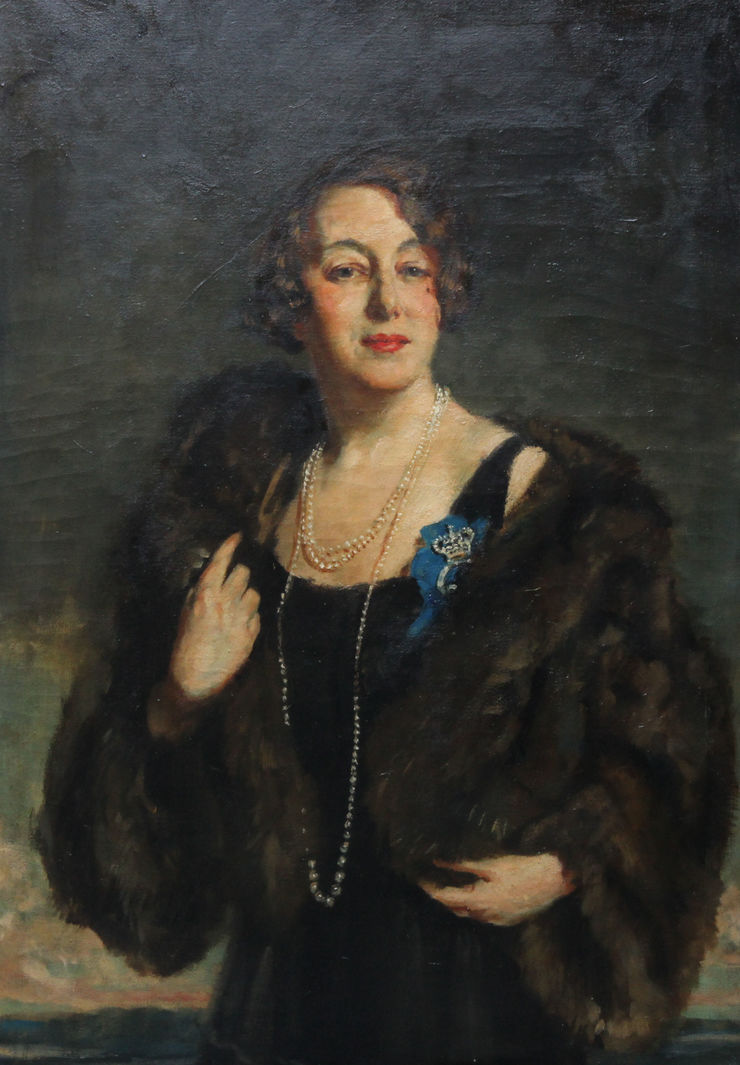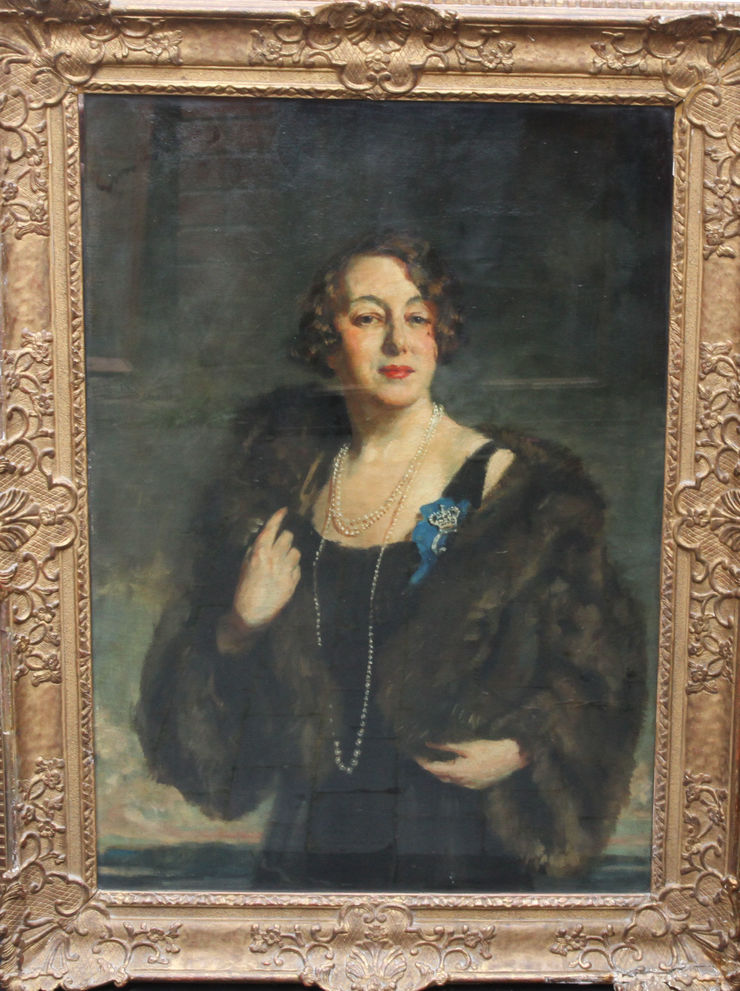Simon Elwes (1902-1975)
| Artist Name | Simon Elwes (1902-1975) |
|---|---|
| Title | Portrait of Contess Sant'Elia |
| Description | This stunning society portrait oil painting is Simon Elwes, much sought after British Royal Academy portrait artist to royalty and leading political figures. The painting is a superb 3/4 length portrait of Contessa Sant'Elia (1881-1965) wearing a black evening dress, short fur jacket, triple string of pearls and a diamond royal insignia, conferred by the king of Italy. The Contessa gazes confidently at the viewer and strikes a natural fluid pose. This is a really stunning portrait by an incredibly famous and sought after artist of his time, thought to date to circa 1930. Contessa Sant'Elia who was married to an Italian nobleman, Luigi Arborio Mella – Conte di Sant’Elia, of a Sardinian family. The Italian royal family were also from Sardinia, and Luigi and his family held positions at court. Rosamond would be a Lady in Waiting to Queen Elena, and become a close friend of other royalty. She wore the badge of her office, conferred by the king of Italy, when she was presented to King George V and Queen Mary in 1930, as seen in our painting. In later years she would receive further honours from the Italian government. Signed top left. |
| Provenance | Family collection. |
| Medium | Oil on Canvas |
| Size | 28 x 40 inches |
| Frame | Housed in complementary frame, 50 inches by 38 inches and in good condition. |
| Condition | Good condition. |
| Biography | Lt. Col. Simon Edmund Vincent Paul Elwes, RP, RA, KM (1902-1975) was a British war artist and society portrait painter whose patrons included presidents, kings, queens, statesmen, sportsmen, prominent social figures and many members of the British Royal Family. He was a favorite of Queen Elizabeth The Queen Mother. Elwes (pronounced "El-wez") was born in1902 at Hothorpe Hall in Northamptonshire (though near Theddingworth, Leicestershire), the sixth and youngest son (two daughters were born later) of famed tenor Gervase Cary Elwes (1866–1921), and his wife, Lady Winifride Mary Elizabeth Feilding, daughter of the 8th Earl of Denbigh. He was the scion of the recusant Cary-Elwes family, of which many branches are known simply as "Elwes", which includes noted British monks and bishops, such as Abbott Columba Cary-Elwes, Archbishop Dudley Cary-Elwes and Father Luke Cary-Elwes. His niece, Polly Elwes, was a famous television personality in Britain. His grandson is the prominent English actor Cary Elwes. Elwes' mother was so determined to have a painter in the family she studied art and even started painting herself while pregnant. For his education Elwes first attended two Catholic schools, Ladycross School in Seaford, and The Oratory School in Edgbaston. In 1918, at the age of sixteen, he was taken out of the Oratory and installed in the Slade School of Fine Art where Henry Tonks and Philip Wilson Steer taught there. After the Slade Elwes spent eight years in Paris, first at the Académie Delécluse and then at the Academie des Beaux Arts. While there he met a Belgian refugee, Mme. La Forge, who aroused his latent interest in painting. Mme. La Forge gave him the run of her studio and encouraged him to start again where he had left off. In 1920, Elwes began studying in ernest at Andre Lhote's Academy in Montparnasse, Paris. Fellow students included Henri Cartier-Bresson, Conrad O'Brien-ffrench and Elena Mumm Thornton Wilson. While in Paris Elwes did a black and white drawing of the Irish tenor and recording artist, John McCormack. McCormack would say to his wife of Elwes: "This lad has remarkable talent and will do big things, mark my words." From France Elwes would visit art galleries in Germany, the Netherlands and Italy. In 1922, Elwes borrowed the price of a ship fare to New York. He repaid the loan by doing charcoal drawings at $5 to $20 apiece. During this visit he managed to draw President Harding from life. In 1926, he returned to England and on 25 November married the Hon. Gloria Elinor Rodd (born 1901), the daughter of the diplomat and scholar, Rennell Rodd, 1st Baron Rennell. After his return from New York a period of undistinguished hard work followed until his portrait of Mrs. James Montgomery Beck, Jr. (née Mary Ridgely Carter) was hung at the Royal Academy of Arts in 1930. A flood of orders followed the next day and continued to do so. The following year Elwes showed another portrait at the Academy of Lady Lettice-Lygon, the first of many aristocratic sitters that would include many of Britain's royal family. Thereafter, his portraits hung in the summer exhibition of the Royal Academy every year. From London's Mayfair to Manhattan's Park Avenue Elwes soon began to establish himself as a stylish, sought after portraitist. In 1929, Elwes was created a Knight of Malta and four years later was elected a member of the Royal Society of Portrait Painters. In 1930, Elwes was invited to paint Robert Baden-Powell founder of the Scout movement. That same year he painted a portrait of The Hon. Lady Aitken. A year later his portrait of the Hon. Mrs. Roger Chetwode was one of nine portraits chosen to be exhibited at The Royal Society of Portrait Painters 45th Annual Show. In 1936, Elwes was commissioned to paint the then Duke of York, in uniform as colonel-in-chief of the 11th Hussars. That December he was commissioned by the new King to paint himself and the Queen, of whom Elwes said, "No couple ever was more popular in England, even before this happened". Two years later he was commissioned to paint another royal portrait of Queen Mary. In December 1938, an exhibition of his work was held at the M. Knoedler & Co. Gallery at 14 East 57th Street in Manhattan which included that portrait. At the outbreak of World War II, Elwes initially joined the Welsh Guards. He was later transferred to the 10th Royal Hussars and was stationed in North Africa and Egypt serving as a lieutenant colonel. After fighting in the battles of Benghazi, Mersa Matruh and Knightsbridge, he was made an official war artist by the local Army command. His role as a war artist was recognized when the War Artists' Advisory Committee purchased several of his works. Whilst stationed in Cairo in 1942 he painted portraits of King Farouk, his wife Queen Farida, their daughter Princess Ferial and Field Marshal Henry Maitland Wilson, General Officer Commanding (GOC) British Troops in Egypt. In South Africa, he painted the portraits of Paul I of the Hellenes, his wife Frederica of Hanover as well as Prime Minister J. C. Smuts and his wife. He painted two other Field Marshals: Sir Claude Auchinleck and in India, Viceroy Archibald Wavell. While there he did portraits of the Maharaja of Patiala, Lord Mountbatten, and various Indian Army soldiers who had won the Victoria Cross. In Delhi, Elwes also gave art lessons sponsored by Lady Wavell (wife of the Viceroy) at the Viceregal Palace. Other instructors included American war artist Millard Sheets. In 1945, Elwes suffered a near-death stroke which paralyzed the right half of both his face and body, including his painting hand. He was diagnosed with hemiplegia. Believing that he was about to die, Elwes received last sacraments. He spent two years in hospital recuperating and, after receiving treatment from renowned physiotherapist Berta Bobath, was soon able to stand with the aid of a cane. During his recovery, Elwes stated that he repeatedly dreamed of the ruins of Fountains Abbey which he had visited in 1933. In the dream he saw the abbey restored and himself talking with one of the monks who kept saying: "It was built for God; it must be returned to God." Elwes became convinced that God had ruined him physically because he had wasted his talent and that he had been chosen to restore the abbey and rededicate it as a monastery. Although he never accomplished his dream, Elwes enlisted the aid of such figures as the Duke of Norfolk, Cardinal Spellman; the Marchioness of Lothian; novelist Evelyn Waugh; Lord Lovat and many of Britain's leading Roman Catholic laymen. Even though he would never regain the use of his right hand, Elwes taught himself to paint with his left surmounting his disability enough to become president of the Guild of Catholic Artists, and vice-president of the Royal Society of Portrait Painters from 1953 to 1957. In 1947, he visited Hollywood and painted a number of movie stars including Gloria Swanson and Bert Lahr. He had become enough of a celebrity himself that in 1949, whilst bedridden in the South of France after suffering a stroke, former British Prime Minister Winston Churchill told Lord Beaverbrook: I think I shall stay here for four or five days. Then I would like to paint with Simon Elwes. In 1953, Elwes was commissioned by Queen Elizabeth, the Queen Mother, to paint the 1948 investiture of her daughter, then Princess Elizabeth with the Order of the Garter by her father King George VI. The next year he would paint a full-length portrait of the Queen, which remains part of the Royal Collection at Windsor Castle. In 1956, Elwes was appointed an associate of the Royal Academy. Besides the Queen he painted King George VI, Princess Margaret and the Duchess of Kent and by 1960, had painted every member of the Royal Family except the Duke of Windsor. Elwes also received a large commission by Viscount Camrose to do a conversation piece of leading members of White's club, of which he was a member. The sitters were Lord Birkenhead, Douglas Fairbanks, Jr., David Stirling, Evelyn Waugh and the Duke of Devonshire set in the coffee room of the club. In 1960, Elwes joined an exhibit of other portraitists at the Portraits, Inc. gallery on West 51st St. in Manhattan. In 1963, he held an exhibition of his work at the Palm Beach Galleries which included portraits of The Hon. John Hay Whitney, (a former Ambassador to the Court of St. James's), Eleanor Robson Belmont, Madame Alain Bertrand, Mr. & Mrs. John S. Borden, Mrs. Henry Pomeroy Davison, William Cox Wright and Randolph Churchill. In 1967, Elwes was made a full member of the Royal Academy. One observer who witnessed him there in his later years, recalls him as being: "Handsome, fresh of complexion, finely dressed, with a scarlet flower in his buttonhole, he enriched the proceedings with his smile, no less than with his air of being a visitor from a world more carefree and elegant than the one in which deficits and disappointments were certain to be discussed." Many of Elwes' paintings can be found in museums, palaces and academies around the world. Some of his early sketches form part of Mark Birley's private collection at Annabel's nightclub in Berkeley Square. |
| Price | SOLD |

